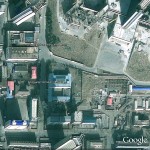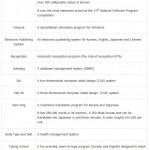UPDATE (1/14/2011): More form Martyn Williams here.
UPDATE (1/13/2011): According to Yonhap:
South Korea has blocked its people in the South from accessing Web sites using North Korea’s national Web domain name, saying the sites contain “illegal information” under the nation’s anti-communism and security laws, officials said Thursday.
The blockage by the South’s state-run Communications Standards Commission came less than a day after an expert said North Korea had renewed the use of its own national Web domain name of “.kp” in an apparent effort to widen public access to its propaganda sites.
The commission started blocking Web sites using the “.kp” domain from Internet users in the South attempting to view those sites, including an Internet portal with an address of http://www.naenara.com.kp, officials said.
“We continue to monitor propaganda activities by North Korea throughout the Internet,” said a commission official. “The Web sites were briefly accessible (in South Korea) because North Korea used its national domain (.kp) it had not used usually.”
Earlier in the day, Martyn Williams of IT research group IDG said in an e-mail that he found http://www.naenara.com.kp operating over the weekend while http://www.friend.com.kp and http://www.star.edu.kp likely came into use at about the same time. All of the sites use “.kp” — assigned to North Korea — as their final domain names.
“It was assigned in 2007 and managed by a company based in Germany, but the domain and a handful of sites also managed by the company disappeared in the second half of last year for reasons that are still unclear,” he wrote in his online article.
The re-emergence of the domain name represents “a step-up in the country’s Internet presence,” Williams said.
Kim Yong-hyun, a North Korea professor at Seoul’s Dongguk University, said, “North Korea seems to be trying to increase public access to its sites as part of its recent online propaganda campaign.”
The sites have separate addresses to allow Internet users to access them. According to Williams, the sites, which include one that represents the North’s official Korean Central News Agency (KCNA), all have their servers based in the communist country.
In the e-mail, the Tokyo-based technology expert said the main record for all the .kp names was updated on Jan. 3.
“So that’s the earliest any of these sites could have reappeared,” he said.
In recent months, North Korea has opened accounts at world-famous sites such as Twitter, YouTube and Facebook, drawing wide public attention. But the one on Facebook no longer operates while its Twitter and YouTube accounts were apparently hacked last weekend.
Naenara at http://www.naenara.com.kp is a multilingual portal site, and http://www.friend.com.kp is mainly an English Web site run by an organ that handles exchanges with other countries. The KCNA has its Web site at http://www.star.edu.kp.
South Korea bans its citizens from accessing pro-North Korea propaganda sites, citing the technical state of war it has been in with Pyongyang since the 1950-53 Korean War ended in a truce.
UPDATE (1/11/2011): Martyn Williams at North Korea Tech offers some more information:
Offline for months, the service has resumed via servers run by Star JV, the Internet joint venture formed by the North Korean government and Thailand’s Loxley Pacific. As reported previously, dot-kp was run by the KCC Europe operation in Germany but went offline in the third quarter of last year.
Two websites are already available via KP domain names. Both are hosted on the same web server. The first, Naenara, has been available for a few months via an IP address and the second, Friend.com.kp, has been offline since its domain name disappeared. You can find out more about each site in The North Korean Website List.
I’ve done a little digging around in the DNS (domain name system) records for KP and found the following eight KP top-level domains have been prepared for future use: net.kp, com.kp, edu.kp, gov.kp, org.kp, rep.kp, tra.kp and co.kp.
Both Naenara and Friend are already using com.kp. A domain name has been prepared for the Star Internet provider: star.net.kp, and one for the state-run Korea Posts and Telecommunications Co.: kptc.kp. I can’t find any other registered domain names at present.
Friends.com.kp is the web page of the Committee for Cultural Relations with Foreign Countries (aka TaeMun. In Korean: 대외문화련락위원회)
UPDATE (1/9/2011): The Naenara URL came back online this weekend. The IP address http://175.45.176.14 has been replaced by the more memorable http://www.naenara.com.kp, though the IP address still works. The Naenara mirror site, kcckp.net, apparently did not survive the transition. Content from 2008 to the present is available, but all the content from 2005-2007 remains off-line and probably will not return.
ORIGINAL POST (Oct 28, 2010): North Korea’s premier web outlet, Naenara, was frequently inactive in the month of August. Sometimes it was there, other times it was not. The web portal was up for one day in September under a slightly different URL. It has not appeared at all under its original URLs in October.
Today, Martyn Williams, who broke the story on the DPRK’s acquisition of a block of IP addresses, reports that Naenara has been migrated to the new DPRK addresses alongside the newly created KCNA web page.
According to Martyn:
North Korea’s Naenara website is back. The site went offline around early September when the dot-kp domain name space went down.
Naenara is run by Pyongyang’s Korea Computer Center and offers news, photos, shopping, tourism information and MP3 files from North Korea.
It’s running inside North Korea’s recently-activated domestic IP address space, but isn’t working perfectly. Some of the links point to dot-kp addresses, which are still not working. It’s worth keeping an eye on.
You can find it at http://175.45.176.14/en/
The IP address Martyn mentions is for the English version.
The Korean version is here: http://175.45.176.14/ko/
The French version is here: http://175.45.176.14/fr/
The Russian version is here: http://175.45.176.14/ru/
The German Version is here: http://175.45.176.14/de/
The Spanish version is here: http://175.45.176.14/sp/
The Chinese version is here: http://175.45.176.14/ch/
The Japanese version is here: http://175.45.176.14/ja/
The Arabic version is here: http://175.45.176.14/ar/
I will go through the new site to see if it is different in any way. One obvious difference is that the archived materials from 2005 & 2007 are gone.


